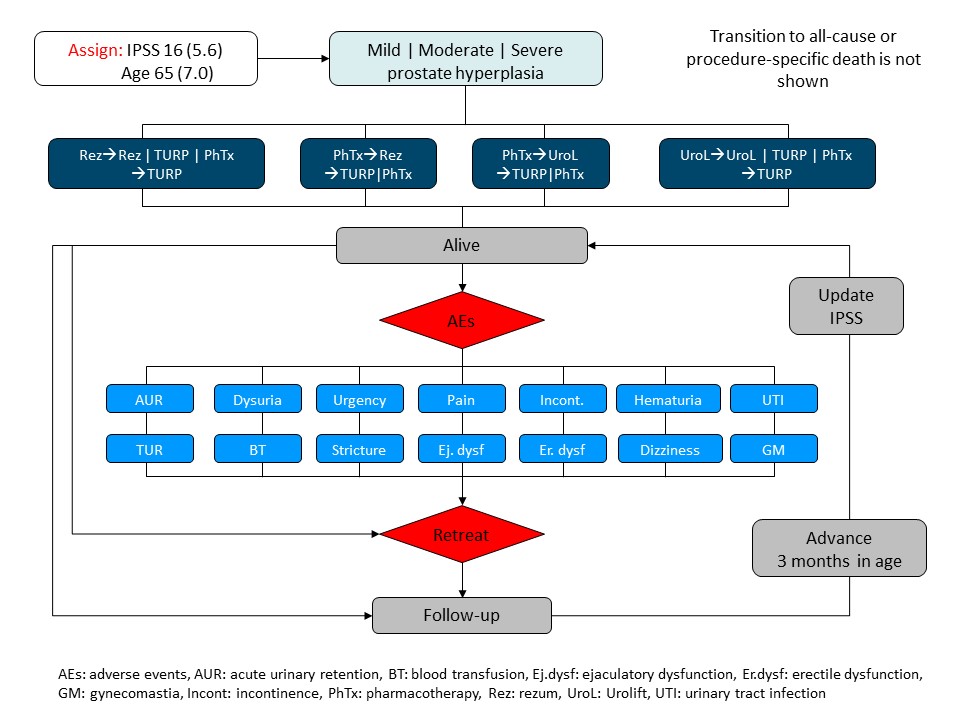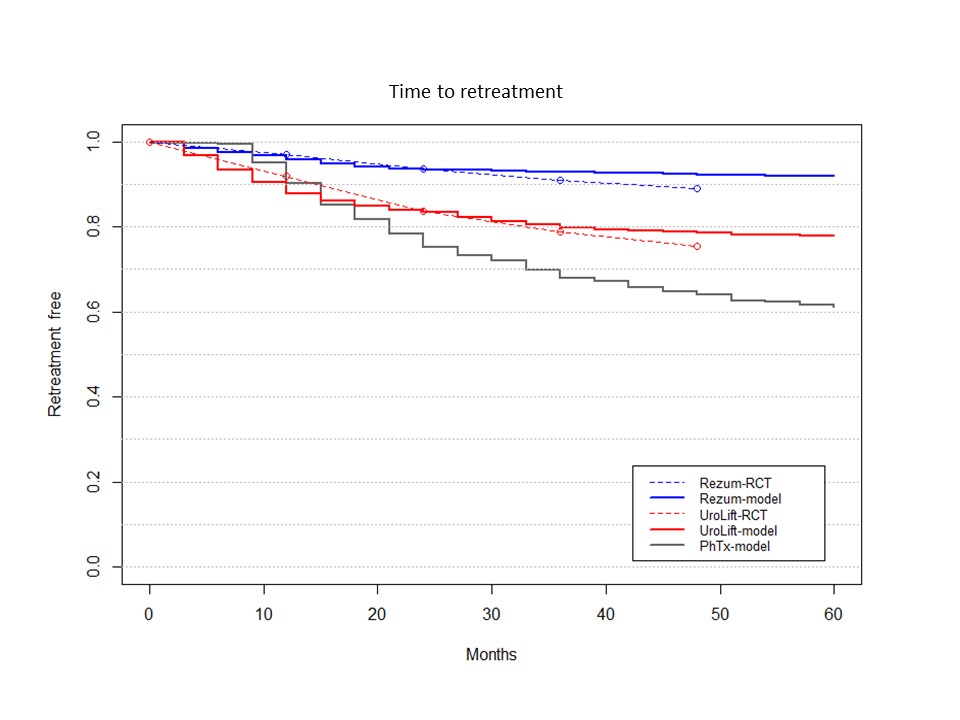Back
Poster, Podium & Video Sessions
MP01: Benign Prostatic Hyperplasia: Surgical Therapy & New Technology I
MP01-12: Pharmacotherapy vs minimally invasive therapies as initial therapy for patients with benign prostate hyperplasia: a microsimulation model
Friday, May 13, 2022
7:00 AM – 8:15 AM
Location: Room 228
Yeva Sahakyan, Aysegul Erman, Toronto, Canada, Naeem Bhojani, Montreal, Canada, Bilal Chughtai, New York, NY, Kevin C Zorn, Montreal, Canada, Beate Sander, Dean Elterman*, Toronto, Canada
- DE
Dean Sol Elterman, MD
MD, MSc, FRCSC
University of Toronto
Poster Presenter(s)
Introduction: This study evaluated the effectiveness of MITs (Rezum and Urolift) compared to pharmacotherapy as initial treatment option for patients with moderate-to-severe BPH.
Methods: We developed a simulation model (image_a) to estimate the impact of Rezum and Urolift compared to pharmacotherapy as initial treatment on International Prostate Symptom Score (IPSS) progression, retreatment rates and quality-adjusted life years (QALYs), discounted at a 1.5% rate. We simulated males with a mean age of 65 years and an average IPSS of 16 over their lifetime.
BPH progression and treatments effects were modeled through the IPSS score. Patients could receive up to two additional lines of therapy: i) patients who started with pharmacotherapy could receive MIT as a second-line, and TURP or pharmacotherapy as a third-line of therapy; ii) patients who started with MIT (Rezum or UroLift) could receive repeated MIT or TURP or pharmacotherapy as a second-line, and TURP as a third line of therapy. Therapy-specific adverse events were applied. The model was informed by data from the published literature.
Results: Simulated health outcomes compared well to the reported trials data (image_b). Over 20 years the proportion of patients who were retreatment free were 49% for Rezum, 39% for Urolift and 50% for pharmacotherapy.
Over the patients’ lifetime initial treatment with Rezum was the most effective option (15.18 QALYs), pharmacotherapy followed by Rezum was the second most effective option (15.08 QALY), followed by Urolift (14.99 QALYs) as initial treatment, and, lastly, pharmacotherapy followed by UroLift (14.98 QALY).
Conclusions: MITs are effective treatment options for moderate-to-severe BPH. These findings will be beneficial for clinicians and health policy makers to further define the implementation of MITs in treatment for BPH.
Source of Funding: Not applicable


Methods: We developed a simulation model (image_a) to estimate the impact of Rezum and Urolift compared to pharmacotherapy as initial treatment on International Prostate Symptom Score (IPSS) progression, retreatment rates and quality-adjusted life years (QALYs), discounted at a 1.5% rate. We simulated males with a mean age of 65 years and an average IPSS of 16 over their lifetime.
BPH progression and treatments effects were modeled through the IPSS score. Patients could receive up to two additional lines of therapy: i) patients who started with pharmacotherapy could receive MIT as a second-line, and TURP or pharmacotherapy as a third-line of therapy; ii) patients who started with MIT (Rezum or UroLift) could receive repeated MIT or TURP or pharmacotherapy as a second-line, and TURP as a third line of therapy. Therapy-specific adverse events were applied. The model was informed by data from the published literature.
Results: Simulated health outcomes compared well to the reported trials data (image_b). Over 20 years the proportion of patients who were retreatment free were 49% for Rezum, 39% for Urolift and 50% for pharmacotherapy.
Over the patients’ lifetime initial treatment with Rezum was the most effective option (15.18 QALYs), pharmacotherapy followed by Rezum was the second most effective option (15.08 QALY), followed by Urolift (14.99 QALYs) as initial treatment, and, lastly, pharmacotherapy followed by UroLift (14.98 QALY).
Conclusions: MITs are effective treatment options for moderate-to-severe BPH. These findings will be beneficial for clinicians and health policy makers to further define the implementation of MITs in treatment for BPH.
Source of Funding: Not applicable


.jpg)
.jpg)